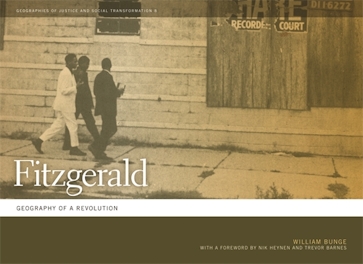Fitzgerald
Geography of a Revolution
Title Details
Illustrations: 237 b&w photos, 40 illus.
Trim size data not found for this book.
Formats
eBook
Pub Date: 09/06/2022
ISBN: 9-780-8203-6499-5
List Price: $27.95
Subsidies and Partnerships
Published with the generous support of Sarah Mills Hodge Fund
Related Subjects
POLITICAL SCIENCE / Public Policy / City Planning & Urban Development
Fitzgerald
Geography of a Revolution
Skip to
- Description
- Reviews
This on-the-ground study of one square mile in Detroit was written in collaboration with neighborhood residents, many of whom were involved with the famous Detroit Geographical Expedition and Institute. Fitzgerald, at its core, is dedicated to understanding global phenomena through the intensive study of a small, local place.
Beginning with an 1816 encounter between the Ojibwa population and the neighborhood’s first surveyor, William Bunge examines the racialized imposition of local landscapes over the course of European American settlement. Historical events are firmly situated in space—a task Bunge accomplishes through liberal use of maps and frequent references to recognizable twentieth-century landmarks.
More than a work of historical geography, Fitzgerald is a political intervention. By 1967 the neighborhood was mostly African American; Black Power was ascendant; and Detroit would experience a major riot. Immersed in the daily life of the area, Bunge encouraged residents to tell their stories and to think about local politics in spatial terms. His desire to undertake a different sort of geography led him to create a work that was nothing like a typical work of social science. The jumble of text, maps, and images makes it a particularly urgent book—a major theoretical contribution to urban geography that is also a startling evocation of street-level Detroit during a turbulent era.
A Sarah Mills Hodge Fund Publication
The reissuing of this classic text in urban geography will excite old students and new. Bunge and his teams soldiered on to overcome countless challenges: social norms, racialized political divides, recalcitrant institutions, and a violent state. More than thirty years after its initial publication, and with the addition of an insightful introductory essay, Fitzgerald will continue to influence geographers. We must not lose sight of the conviction and hope of radical possibilities in American cities set forth by Bunge and his geographical expeditions.
—Alison Mountz, author of Seeking Asylum: Human Smuggling and Bureaucracy at the Border
There’s nobody like Bill Bunge and there’ll never be anyone like him again. Fitzgerald is another way of telling a story about city life, about its horrors and threats, its joys and possibilities. Our cities continue to crumble, disintegrate financially and socially; yet geographers fret about tenure reviews and research evaluations. How can we not feel shame reading Bunge’s great book today? He’s our conscience, he gnaws away inside us, always forcing us to consider who we are as scholars and what we should do to save life on planet urban.
—Andy Merrifield, author of Henri Lefebvre: A Critical Introduction
